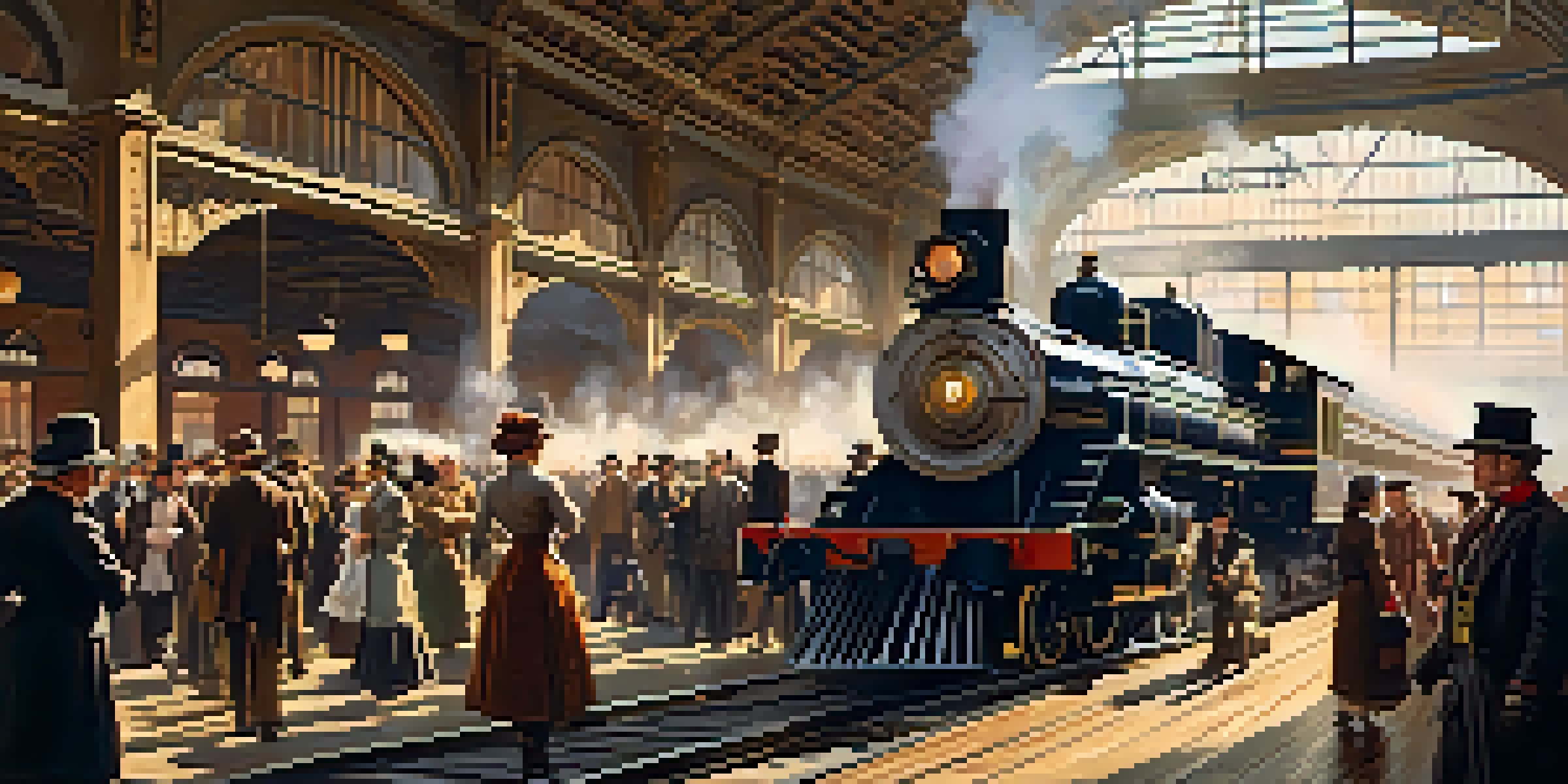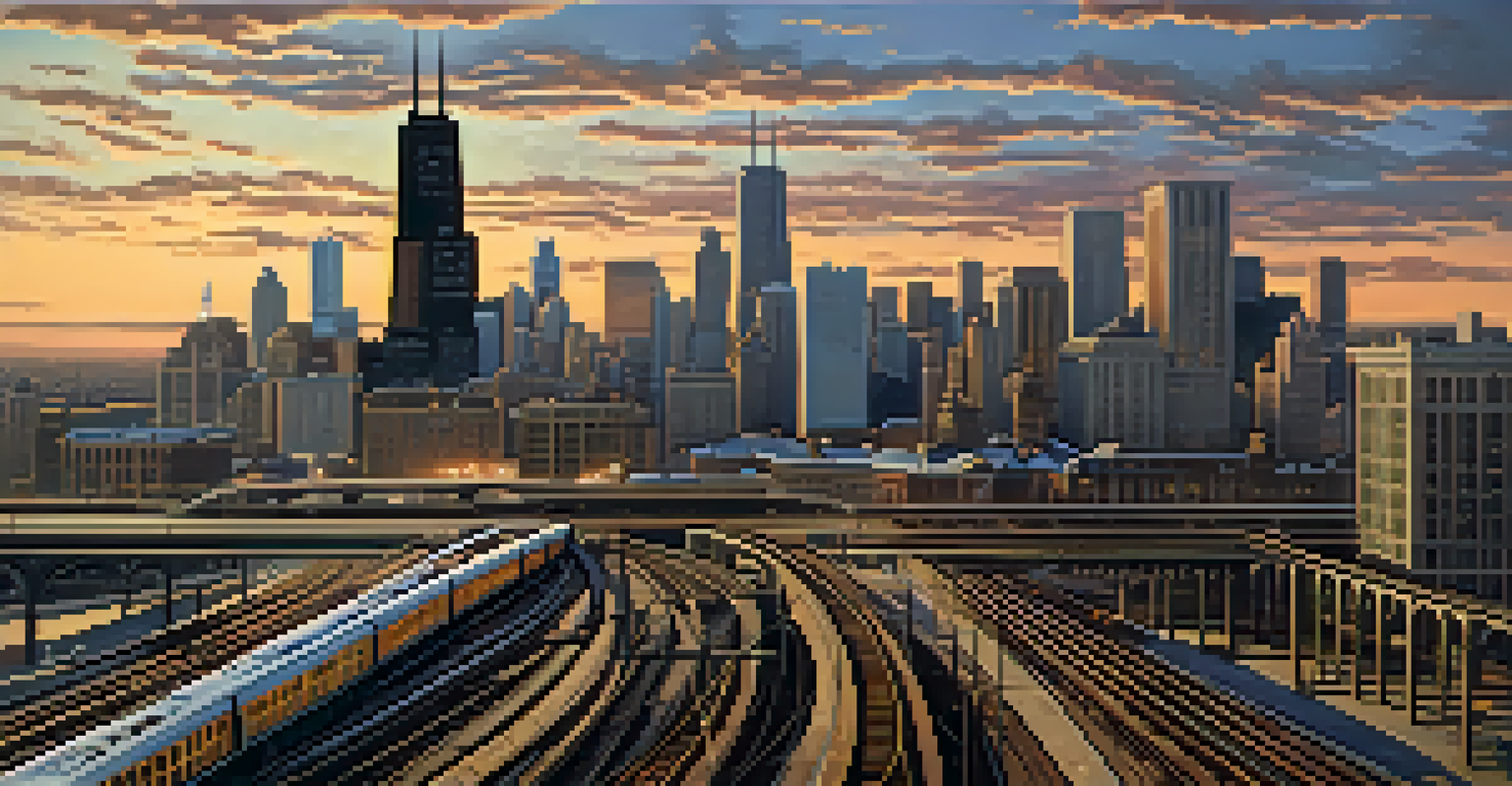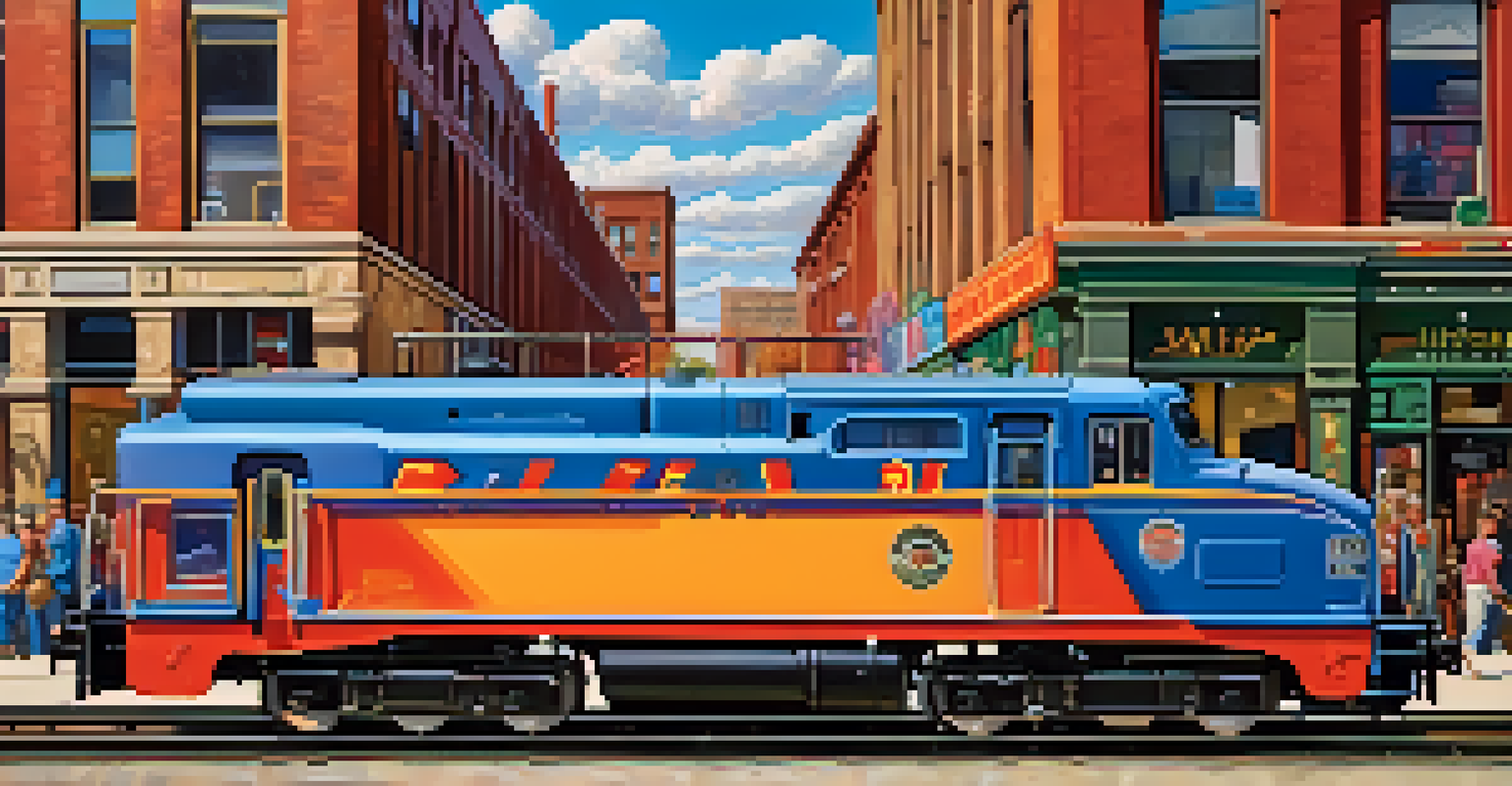The Birth of Railroads in Chicago: A Historical Overview

The Early Beginnings of Railroads in Chicago
The history of railroads in Chicago begins in the early 19th century, a time when the city was still finding its footing. The first rail line, the Galena and Chicago Union Railroad, began construction in 1848, laying the groundwork for what would become a bustling network. This initial route connected Chicago to the rich resources of northern Illinois, effectively changing the economic landscape of the region.
The locomotive is the most important invention of the 19th century. It made transportation faster, safer, and more efficient.
As railroads emerged, they brought with them the promise of progress and prosperity. People were drawn to Chicago for job opportunities and the potential for a better life. The city quickly transformed from a small settlement into a growing metropolis, thanks to the influx of goods and people facilitated by the new railroads.
By the 1850s, Chicago had established itself as a major transportation hub. The railroads not only connected the Midwest to the East Coast but also opened up trade routes to the West. This was a pivotal period, as the railroads helped to shape the identity of Chicago as a center of commerce and innovation.
The Role of the Civil War in Railroad Expansion
The Civil War (1861-1865) played a significant role in accelerating the expansion of railroads in Chicago. With the demand for supplies and troops, railroads became vital for military logistics. Chicago's railroads were uniquely positioned to transport goods quickly, making them essential to the war effort.

As the war progressed, the federal government recognized the importance of railroads for national security. This led to increased investment in railroad infrastructure, which would benefit Chicago in the long run. The city’s rail lines were expanded and modernized, setting the stage for post-war growth.
Railroads Fueled Chicago's Growth
The development of railroads in the 19th century transformed Chicago into a bustling metropolis and a vital transportation hub.
Once the war ended, the railroad boom continued, fueled by the need to rebuild and expand the nation. Chicago emerged from the conflict with an extensive network of railroads, solidifying its reputation as a key player in the transportation industry. The city's strategic location became even more critical as America entered a new era of economic expansion.
The Rise of Major Rail Companies in Chicago
As railroads flourished, several major companies began to establish their presence in Chicago. The Illinois Central Railroad, the Chicago, Burlington and Quincy Railroad, and the Atchison, Topeka and Santa Fe Railroad are just a few examples. These companies not only expanded the rail network but also created jobs and stimulated the local economy.
Trains are a symbol of progress; they connect people and places, creating opportunities for growth and development.
The competition among these companies led to innovations in rail technology and services. They introduced faster trains, better scheduling, and improved freight handling. This era of competition ensured that Chicago remained at the forefront of the railroad industry, attracting businesses and settlers alike.
By the end of the 19th century, Chicago had become the railroad capital of the United States. The city was home to numerous rail yards, terminals, and depots, which facilitated the movement of millions of passengers and tons of freight. The scale of operations was impressive, reflecting the city’s growing influence on national trade and commerce.
The Impact of Railroads on Chicago's Economy
The railroads revolutionized Chicago's economy, transforming it into a bustling hub of trade and commerce. With the ability to transport goods efficiently, businesses flourished, and new industries emerged. Chicago became known for its meatpacking, grain, and manufacturing sectors, all fueled by the railroad network.
Moreover, the railroads attracted a diverse workforce, leading to population growth and cultural exchange. Immigrants from various backgrounds arrived, seeking opportunities and contributing to the vibrant tapestry of the city. This influx of people also sparked demand for goods and services, further boosting the local economy.
Civil War Boosted Railroad Expansion
The Civil War accelerated railroad expansion in Chicago, enhancing its infrastructure and positioning the city for post-war economic growth.
As the economy grew, so did the city's infrastructure. Investments in roads, bridges, and public services followed, creating a more connected and livable environment. The railroads not only shaped the economy but also the very fabric of Chicago, laying the foundation for its future development.
Challenges Faced by Chicago's Railroad System
Despite the success of railroads in Chicago, the system faced several significant challenges. Overcrowding and congestion became common as more trains and freight cars filled the tracks. This led to delays and safety concerns, prompting calls for improvements in infrastructure and management.
Additionally, the rise of automobile travel and the construction of highways posed a new threat to the railroad industry. As people began to prefer cars for personal travel, railroads had to adapt to changing transportation preferences. This shift forced many companies to rethink their strategies and services.
Moreover, economic downturns, such as the Great Depression, severely impacted the railroads' profitability. Many companies struggled to survive, leading to mergers and consolidations. Despite these challenges, the railroads continued to play a vital role in Chicago's economy, demonstrating resilience and adaptability.
The Modernization of Railroads in Chicago
In the latter half of the 20th century, Chicago's railroads underwent significant modernization. Advances in technology, such as diesel locomotives and improved signaling systems, enhanced efficiency and safety. These innovations allowed railroads to compete more effectively with other modes of transportation.
The introduction of containerization revolutionized freight transport, enabling goods to be shipped more easily and efficiently. Chicago became a critical hub for intermodal shipping, where cargo could be transferred between trucks and trains seamlessly. This shift not only boosted the economy but also solidified the city's role in global trade.
Cultural Impact of Railroads
Beyond economics, railroads shaped Chicago's cultural landscape, symbolizing freedom and connecting diverse communities.
Today, Chicago's railroads continue to evolve, incorporating sustainable practices and focusing on reducing environmental impacts. The city remains a vital center for rail transport, with ongoing investments in infrastructure and technology. This commitment to modernization ensures that railroads will remain an integral part of Chicago's identity for years to come.
The Cultural Significance of Railroads in Chicago
Beyond their economic impact, railroads have shaped the cultural landscape of Chicago. They have influenced literature, music, and art, often symbolizing freedom, adventure, and the promise of new beginnings. The imagery of trains has been a powerful motif in Chicago's cultural narrative.
Moreover, railroads have played a role in community building. They connected people from different backgrounds and regions, fostering a sense of unity and shared experience. Festivals, parades, and other events celebrating the railroad heritage have become cherished traditions in the city.

As we reflect on the history of railroads in Chicago, it's clear that they are more than just a means of transportation. They represent the spirit of progress and innovation that defines the city. The legacy of railroads continues to inspire future generations, reminding us of the importance of connectivity and collaboration.